The First Post Office
Wednesday, April 13th, 2022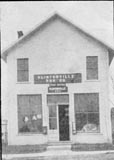 If you have not yet joined the Clintonville Historical Society, well, you ought to! Mary Rodgers sends out an interesting monthly newsletter that is chock-a-block full of good articles. In the October 2017 issue, she penned an article about Clintonville’s first post office.
If you have not yet joined the Clintonville Historical Society, well, you ought to! Mary Rodgers sends out an interesting monthly newsletter that is chock-a-block full of good articles. In the October 2017 issue, she penned an article about Clintonville’s first post office.
Celebrating 170 years: The first Post Office
by Mary Rodgers
October 2017
We celebrate Clintonville’s birthday on September 13, 1847. That is the day that a post office opened using the name “Clintonville”. We know that the small town between Columbus and Worthington existed prior to the date but because the town was never formally platted, we do not have an alternative formal start date. On September 13, 1847, James Ferguson was appointed postmaster at the Clintonville Post Office. It was the practice at the time to locate the post office in a business operated by the postmaster. The names of the offices were determined by the postmaster and were usually associated with the area that they were located, the postmaster’s name or the postmaster’s business. In 1933, The Booster printed a photo of the post office. That photo is of a rug store! Mr. Ferguson was a blacksmith. Maybe he had a side operation?
Or, maybe this photo captured the building where Clintonville’s second postmaster set up operation? Harmon “Hammer” Houck was Clintonville’s second postmaster. He reigned from November of 1852 to April of 1854. The 1850 census lists him as a peddler. That might be consistent with a rag rug dealer.
James Ferguson reclaimed the position of postmaster in April of 1854. He and family originated in Lancaster Co. Pennsylvania. He was the son of John and Susanah (Hood) Ferguson. James was married to Hannah Murray around 1824. The Fergusons, at least three generations, came to Ohio in 1843. They arrived by wagon (note: Lancaster County, Pa is the birthplace of the Conestoga wagon!). Based on area maps, James purchased his Clintonville property from Alanson Bull. A question would be: How did Ferguson become aware of Bull’s interest in building a town? Did Bull run advertisements in Eastern newspapers of the time? That is a question for another day.
According to the 1850 Census, James Ferguson owned 5 acres of land, a home, two milk cows, a beef cow, five pigs, and 100 bushels of corn. His livestock was valued a $98, his machinery at $41 and his overall estate at $950. His estate was higher in value then his neighbors with more land. Perhaps that is an indication of its geographical position “in town”? Hannah Murray Ferguson, James’s wife, was a Quaker. Quakers were known to be involved in the Underground Railroad and the Fergusons are a part of the Clintonville Underground Railroad story. The Ferguson sons Joseph, John and Samuel all served in the Civil War. His son Joseph died in action in Perryville, KY. According to K. Haefner, 3rd great granddaughter of Hannah and James Ferguson, when sons John and Samuel returned from the war, the family moved to Findlay, OH. It would seem that John and Samuel met a number of men from Hancock County while serving. Those men told stories of the land and those tales impressed these young men. In Findlay, Samuel and John pursed wagon making. The shop they opened remained in operation beyond 1911.
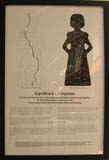
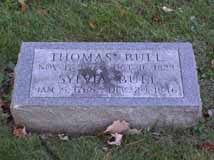 People like to say that the story of Clintonville starts with the story of Thomas Bull Jr., who came to this area in 1812 with his family from Vermont, by way of Worthington. Bull purchased about 680 acres in Clinton Township, and bequeathed land to his children when he died in 1823. Bull and his family were Methodists and abolitionists. The family graves were moved in March 1910 to Union Cemetery, section “new”, lot 176, across from the flagpole. (Despite the section name, this is in the old area of Union Cemetery on the east side of Olentangy River Road.)
People like to say that the story of Clintonville starts with the story of Thomas Bull Jr., who came to this area in 1812 with his family from Vermont, by way of Worthington. Bull purchased about 680 acres in Clinton Township, and bequeathed land to his children when he died in 1823. Bull and his family were Methodists and abolitionists. The family graves were moved in March 1910 to Union Cemetery, section “new”, lot 176, across from the flagpole. (Despite the section name, this is in the old area of Union Cemetery on the east side of Olentangy River Road.)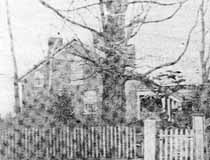 This is the Thomas Bull residence which stood on the east side of High Street between Dunedin and Piedmont. Some of the information about the house is conflicting, but Nancy Pendleton states that Alonson Bull helped to build the house around 1821 and lived there until the mid-1860s. The local Methodist congregation held services in this house until Thomas Bull’s death in 1823. Elias Pegg purchased it, along with its farm, in 1862 and raised his children there. The house was torn down in August 1931. This photo is from the Sunday edition of Cols Dispatch March 5, 1950.
This is the Thomas Bull residence which stood on the east side of High Street between Dunedin and Piedmont. Some of the information about the house is conflicting, but Nancy Pendleton states that Alonson Bull helped to build the house around 1821 and lived there until the mid-1860s. The local Methodist congregation held services in this house until Thomas Bull’s death in 1823. Elias Pegg purchased it, along with its farm, in 1862 and raised his children there. The house was torn down in August 1931. This photo is from the Sunday edition of Cols Dispatch March 5, 1950.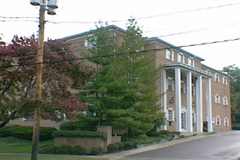 Henry Brevoort’s house was built at
Henry Brevoort’s house was built at 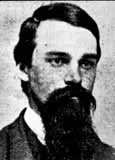 James G. Bull (1838-1927) was a grandson of Thomas Bull. James served as Columbus Mayor from 1865 to 1868 and from 1871 to 1875. His grandfather, Thomas Bull, was the first white settler of the area and James’ father, Alonson Bull, founded Clintonville in 1846. (Photo courtesy of Columbus Metropolitan Libraries)
James G. Bull (1838-1927) was a grandson of Thomas Bull. James served as Columbus Mayor from 1865 to 1868 and from 1871 to 1875. His grandfather, Thomas Bull, was the first white settler of the area and James’ father, Alonson Bull, founded Clintonville in 1846. (Photo courtesy of Columbus Metropolitan Libraries)